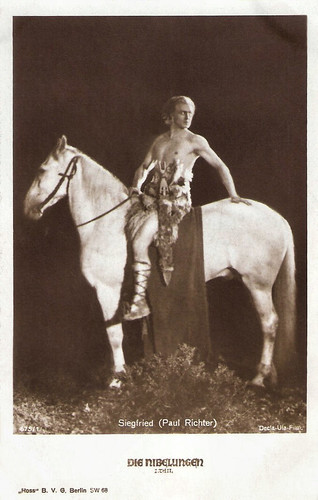
German postcard by Ross Verlag, Berlin, no. 675/1. Photo: Decla-Ufa-Film. Publicity still for Die Nibelungen: Siegfried (Fritz Lang, 1924) with Paul Richter.
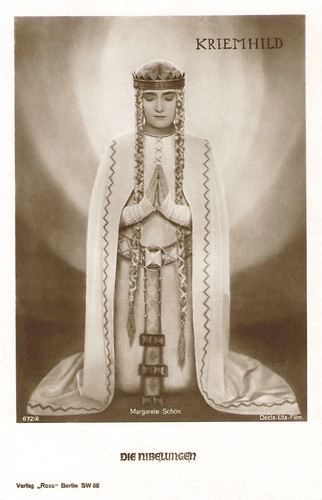
German postcard by Ross Verlag, no. 672/6. Photo: Decla-Ufa-Film. Publicity still for Die Nibelungen (Fritz Lang, 1924) with Margarete Schön.
How Siegfried Slayed the Dragon
Die Nibelungen (Fritz Lang, 1924) is one of the masterpieces of the Weimar cinema. Die Nibelungen is a diptych of silent fantasy films: Die Nibelungen: Siegfried and Die Nibelungen: Kriemhilds Rache/Kriemhild's Revenge.
It was produced by the Ufa and Decla studios, and it starred Austrian actor Paul Richter as the (nearly) invulnerable hero Siegfried. In 1924, Ross Verlag published a beautiful series of sepia-tinted postcards with stills of this classic film.
The screenplays were written by Fritz Lang and his wife at the time, Thea von Harbou. They were based upon the epic Nordic poem 'Nibelungenlied', written around AD 1200 and told through seven cantos.
It is the tale of the legendary German hero Siegfried (Paul Richter), son of King Siegmund. He masters the art of forging a sword at the shop of Mime (Georg John). On his journey home, he hears tales from the locals about Princess Kriemhild (Margarete Schön), the beautiful sister of King Gunter of Burgundy (Theodor Loos).
Siegfried decides to go to Worms, the capital of Burgundy, to win Kriemhild. On his journey to Worms, he is attacked by a dragon. Siegfried slays the dragon and bathes in his blood. his bath makes him invulnerable - except for one spot on his shoulder blade which is missed after being covered by a falling lime leaf.
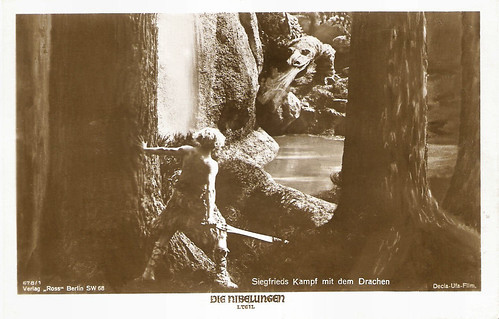
German postcard by Ross Verlag, no. 678/1. Photo: Decla / Ufa-Film. Publicity still for part I. of Die Nibelungen (Fritz Lang, 1924) with Paul Richter as Siegfried. Caption: Siegfried's fight with the dragon.
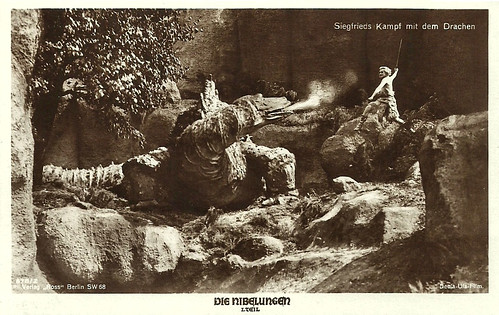
German postcard by Ross Verlag, no. 678/2. Photo: Decla-Ufa-Film. Publicity still for Die Nibelungen: Siegfried (Fritz Lang, 1924). Caption: Siegfried's fight with the dragon.
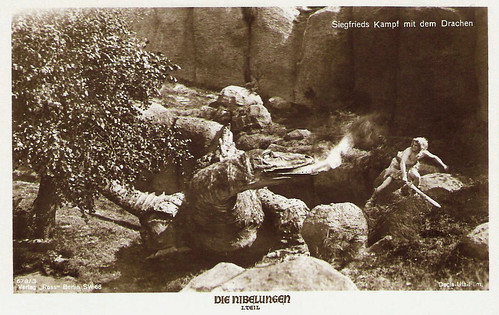
German postcard by Ross Verlag, Berlin, no. 678/3. Photo: Decla-Ufa-Film. Caption: Siegfried's fight with the dragon.

German postcard by Ross Verlag, no. 678/4. Photo: Decla-Ufa-Film. Publicity still for Die Nibelungen: Siegfried (Fritz Lang, 1924). Caption: Siegfried bathes in the dragon's blood. After slaying the dragon, Siegfried (Paul Richter) bathes in the dragon's blood, which will make him invulnerable. Incidentally, a leaf falls on his back, creating Siegfried's one weak spot (his Achilles heel). When the vain and arrogant Paul Richter refused to strip for this scene, Lang called in the not-so-pretty Rudolf Klein-Rogge (Etzel - Attila - in the film), who immediately undressed and played the scene, to the dismay of Richter, as people now would identify Klein-Rogge's behind as his.
How Volker, the Bard, sang of Siegfried in front of Kriemhild, and How Siegfried Came in Worms
Siegfried trespasses on the land of the Nibelungen and is attacked by Alberich, King of the Dwarves (again Georg John).
Siegfried fights and defeats Alberich who was wearing his wonder cloak of invisibility and transformation. Alberich asks Siegfried to spare his life and in return, he gives the Treasure of the Nibelungen and the Balmung sword.
While Siegfried is mesmerised by the treasure, Alberich tries to defeat him but dies in the attempt. Dying, Alberich curses all inheritors of the treasure and he and his dwarves turn to stone.
Siegfried makes twelve kings as his vassals and arrives in Worms as a hero.
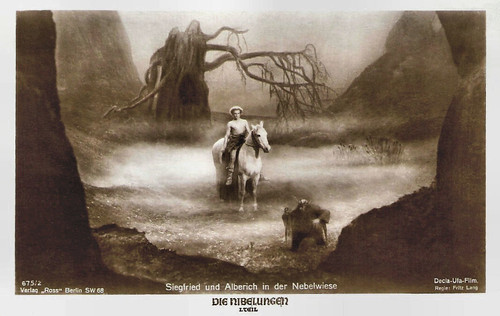
German postcard by Ross Verlag, Berlin, no. 675/2. Photo: Decla-Ufa-Film. Publicity still for Die Nibelungen: Siegfried (Fritz Lang, 1924). Caption: Siegfried and Alberich in the fog meadow.
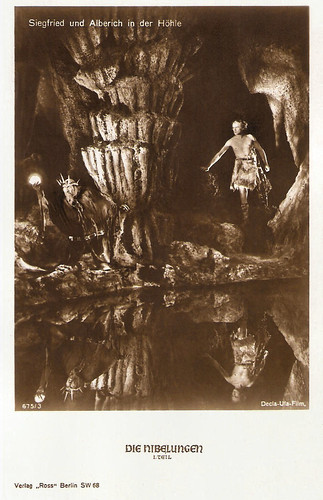
German postcard by Ross Verlag, Berlin, no. 675/3. Photo: Decla-Ufa-Film. Publicity still for Die Nibelungen: Siegfried (Fritz Lang, 1924) with Paul Richter as Siegfried and Georg John as Alberich. Caption: Siegfried and Alberich in the cave.
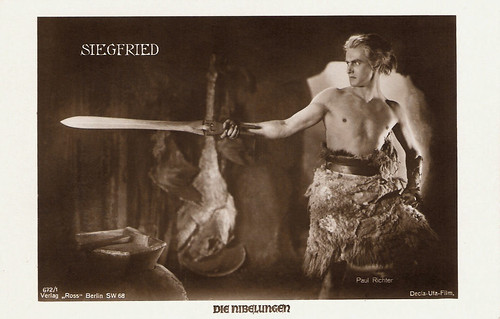
German postcard by Ross Verlag, Berlin, no. 672/1, 1924. Photo: Decla-Ufa-Film. Publicity still for Die Nibelungen: Siegfried (Fritz Lang, 1924).
How Siegfried Won Brunhild for Gunther
News reaches the court that Brunhild, a queen of outstanding strength and beauty may be won only by a man capable of matching her athletic prowess.
Gunther decides to woo Brunhild (Hanna Ralph) with the aid of Siegfried, to whom he promises the hand of Kriemhild if successful.
The men travel to Iceland, to the kingdom of Brunhild, where Siegfried feigns vassalage to Gunther so that he can avoid Brunhild's challenge.
He uses instead the cloak's power of invisibility to help Gunther beat the powerful Queen in a three-fold Amazonian battle of strength: throwing stones, throwing a spear and jumping.
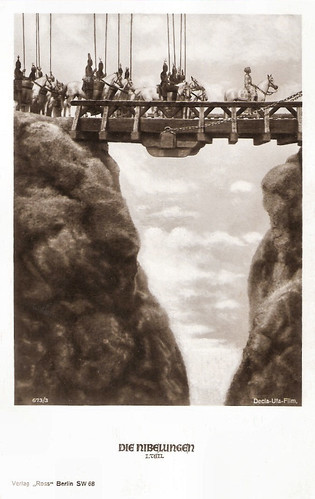
German postcard by Ross Verlag, Berlin, no. 673/3. Photo: Decla-Ufa-Film. Publicity still for Die Nibelungen: Siegfried (Fritz Lang, 1924).
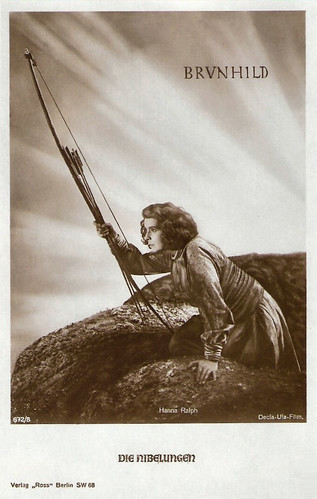
German postcard by Ross Verlag, Berlin, no. 672/8. Photo: Decla-Ufa-Film. Publicity still for Die Nibelungen: Siegfried (Fritz Lang, 1924) with Hanna Ralph as Brunhild.
How Brunhild Enters Worms and How the King Celebrate Their Wedding
The men return to Burgundy where Gunther marries Brunhild and Siegfried weds Kriemhild.
Brunhild is not, however, completely defeated. She suspects deceit and says to Gunther that she is his captive but not his bride.
Hagen von Tronje (Hans Adalbert Schlettow) convinces Siegfried to help. Siegfried transforms himself with the cloak into Gunther and battles Brunhild and removes her arm ring during battle after which she submits to his will.
Siegfried leaves the real Gunther to consummate the marriage. Siegfried accidentally brings Brunhild's armlet with him.
On the postcard below Siegfried presents Kriemhild the circlet.
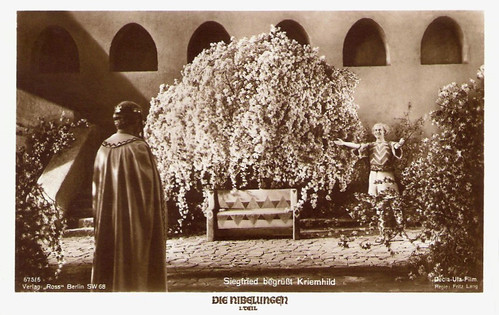
German postcard by Ross Verlag, Berlin, no. 675/6. Photo: Decla-Ufa-Film. Publicity still for Die Nibelungen: Siegfried (Fritz Lang, 1924). Caption: Siegfried greets Kriemhild.

German postcard by Ross Verlag, no. 673/1. Photo: Decla / Ufa-Film. Publicity still for Siegfried (Paul Richter) and Kriemhild (Margarete Schön) in part I. of Die Nibelungen (Fritz Lang, 1924).
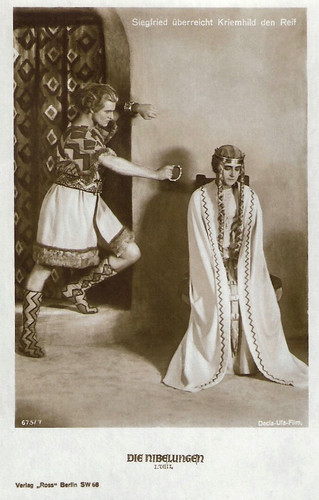
German postcard by Ross Verlag, Berlin, no. 675/7. Photo: Decla-Ufa-Film. Publicity still for Die Nibelungen: Siegfried (Fritz Lang, 1924). Siegfried (Paul Richter) presents Kriemhild (Margarete Schön) the circlet.
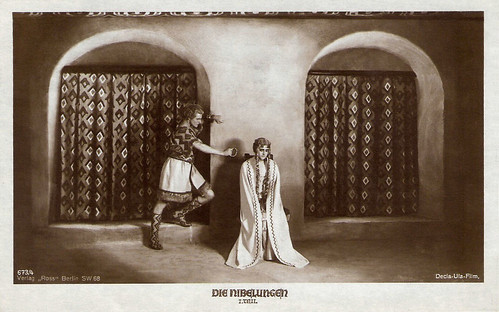
German postcard by Ross Verlag, Berlin, no. 673/4. Photo: Decla-Ufa-Film. Publicity still for Die Nibelungen: Siegfried (Fritz Lang, 1924).
How After Half a Year, Siegfried's Gift to His Bride, The Nibelungen Treasure, Arrives in Worms and How the Two Queens Quarrel With Each Other
When Kriemhild finds Brunhild's armlet, Siegfried tells her how her brother won the queen.
When the Nibelungen treasure that Siegfried acquired from Alberich arrives at the court of Burgundy as Kriemhild's morning gift, the jealous Brunhild becomes more suspicious about Siegfried's feigned vassalage to Gunther.
Brunhild dons the Queen Mother's jewellery and proceeds to the cathedral to enter as the first person, as is her right as Queen of Burgundy.
Kriemhild and Brunhild quarrel. Brunhild ridicules Kriemhild for marrying a vassal, and Kriemhild reveals Siegfried’s and Gunther’s deception.
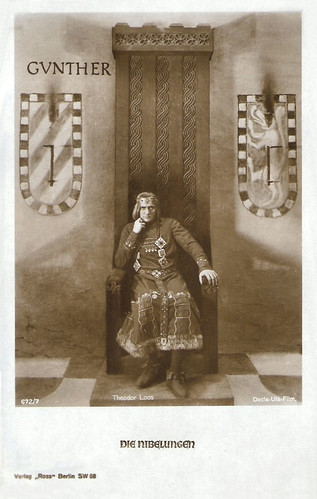
German postcard by Ross Verlag, Berlin, no. 672/7. Photo: Decla-Ufa-Film. Publicity still for Die Nibelungen: Siegfried (Fritz Lang, 1924) with Theodor Loos as Gunther.

German postcard by Ross Verlag, Berlin, no. 673/2. Photo: Decla-Ufa-Film. Publicity still for Die Nibelungen: Siegfried (Fritz Lang, 1924). Siegfried (Paul Richter) in the woods.

German postcard by Ross Verlag, Berlin, no. 675/5. Photo: Decla-Ufa-Film. Publicity still for Die Nibelungen, part I, Siegfried (Fritz Lang, 1924). Kriemhild (Margarete Schön) and the women in the 'kemenate', the heated private room of the castle, also called 'cabinet'.
How Gunther Betrayed Siegfried
Brunhild demands Siegfried be killed. She lies to Gunther and tells him that Siegfried stole her maidenhood when he battled her on her wedding night.
King Gunther and his uncle and loyal warrior, Hagen von Tronje (Hans Adalbert Schlettow), conspire to murder Siegfried during a hunt in the Odenwald Forest.
Hagen deceives Kriemhild into telling him the vulnerable part of Siegfried's body where the leaf has fallen. She sews a cross on the spot in Siegfried's tunic.
After the hunt, Hagen challenges Siegfried to a race to a nearby spring.
When Siegfried is on his knees drinking, Hagen pierces him from behind with a spear.
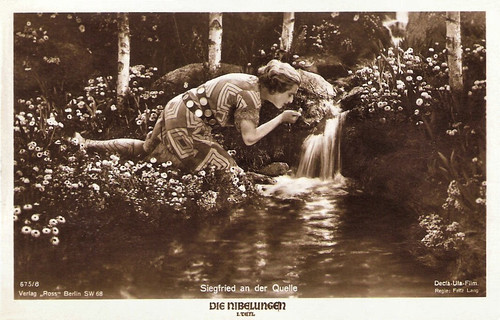
German postcard by Ross Verlag, Berlin, no. 675/8. Photo: Decla-Ufa-Film. Publicity still for Die Nibelungen: Siegfried (Fritz Lang, 1924). Caption: Siegfried at the well.
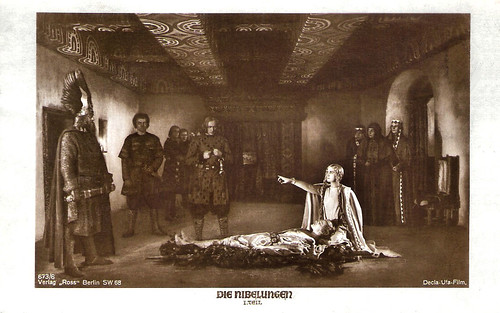
German postcard by Ross Verlag, no. 673/6. Photo: Decla-Ufa-Film. Publicity still for Die Nibelungen (Fritz Lang, 1924) with Margarete Schön as Kriemhild near the corpse of Siegfried (Paul Richter). She points at the murderer Hagen Tronje (Hans Adalbert Schlettow). Her brother, King Gunther (Theodor Loos), is standing next to her.
How Kriemhild Swears Revenge to Hagen Tronje
On the postcard below Kriemhild (Margarete Schön) and Brunhild (Hanna Ralph) mourn by the body of Siegfried (Paul Richter).
In an evil twist of bitter revenge, Brunhild confesses that she lied about Siegfried stealing her maidenhood in order to avenge Gunther's deceit of her. Gunther killed his only loyal friend.
Kriemhild demands her family avenge her husband's death at the hands of Siegfried, but her family is complicit in the murder, so they protect Hagen.
Kriemhild swears revenge against Hagen while a guilt-ridden Brunhild commits suicide at the foot of Siegfried's corpse laid in state in the cathedral. Kriemhild swears revenge to Hagen.
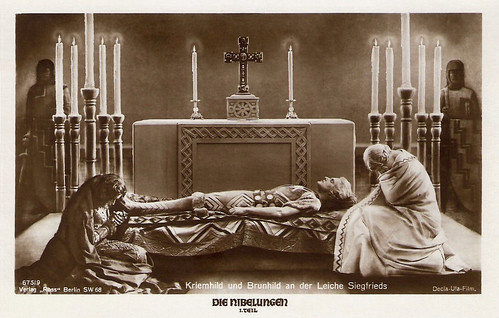
German postcard by Ross Verlag, Berlin, no. 675/9. Photo: Decla-Ufa-Film. Publicity still for Die Nibelungen: Siegfried (Fritz Lang, 1924).
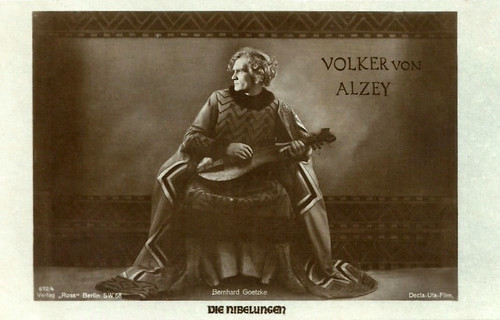
German postcard. Decla-Ufa-Film. Ross Verlag, no. 672/4. Bernhard Goetzke as Volker von Alzey, the bard in Die Nibelungen (1924).
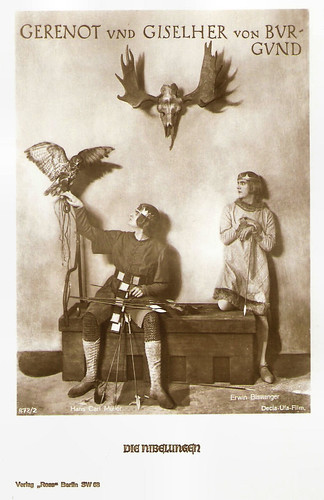
German postcard by Ross Verlag, no. 672/2. Photo: Decla / Ufa-Film. Publicity still for part I. of Die Nibelungen (Fritz Lang, 1924) with Hans-Carl Müller as Gerenot von Burgund and Erwin Biswanger as Giselher von Burgund.

German postcard by Ross Verlag, no. 672/3. Photo: Decla / Ufa-Film. Publicity still for Die Nibelungen (Fritz Lang, 1924) with Gertrud Arnold as Queen Ute.
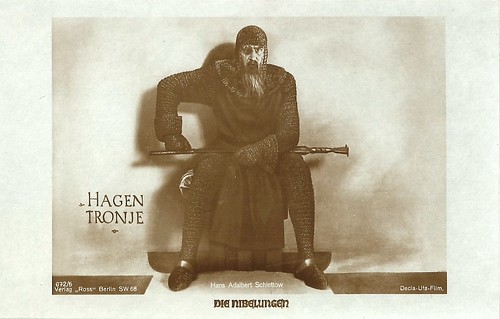
German postcard by Ross Verlag, Berlin, no. 672/5. Photo: Decla-Ufa-Film. Hans Adalbert Schlettow as Hagen (von) Tronje in Fritz Lang's saga Die Nibelungen (1924).
Kriemhild's Revenge
In the second film, Kriemhild's Rache/Kriemhild's Revenge is shown how Kriemhild (Margarete Schön) gets her revenge.
After Siegfried's dead, Kriemhild marries Etzel, the King of the Huns. She gives birth to a child and invites her brothers to a party.
She tries to persuade Etzel and the other Huns, that they kill Hagen, the murderer of Siegfried, but he is protected by her brothers. A fierce battle begins to force her brothers to give Hagen to her.
Probably no literary work has given more to Germanic arts than the Nibelungenlied. Many variations and adaptations appeared through the centuries. The most significant modern adaptation is Richard Wagner’s famous opera cycle 'Der Ring des Nibelungen' (1853–1874).
The 1924 film Die Nibelungen is still astounding to look at. Fritz Lang gives the film a real sense of wonder by way of fantasy elements such as dwarfs, dragons and magic powers. It's amazing that such a masterpiece of cinema could have been made in the early 1920s. The standout is the dragon-slaying scene with its wonderful special effects.

German postcard by Ross Verlag, Berlin, no. 675/4. Photo: Decla-Ufa-Film. Margarete Schön and Bernhard Goetzke in Die Nibelungen: Kriemhilds Rache/Die Nibelungen: Kriemhild's Revenge (Fritz Lang, 1924).
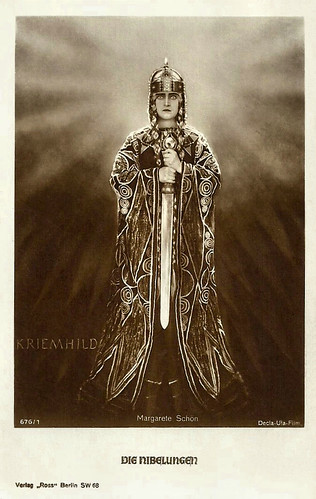
German postcard by Ross Verlag, Berlin, no. 676/1. Photo: Decla-Ufa-Film. Publicity still for Die Nibelungen (Fritz Lang, 1924) with Margarete Schön as Kriemhild.
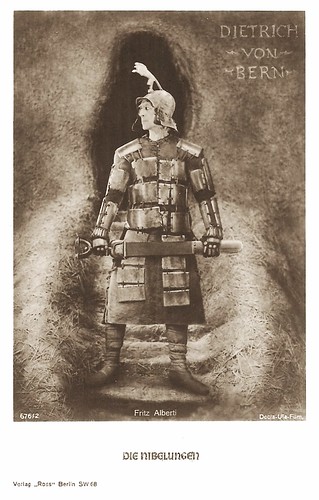
German postcard by Ross Verlag, Berlin, no. 676/2. Photo: Decla-Ufa-Film. Fritz Alberti as Dietrich von Bern in Fritz Lang's medieval saga Die Nibelungen (1924).
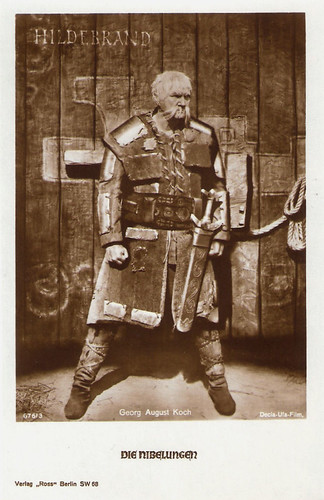
German postcard by Ross Verlag, no. 676/3. Photo: Decla / Ufa-Film. Publicity still for Die Nibelungen (Fritz Lang, 1924) with Georg August Koch as Hildebrand.
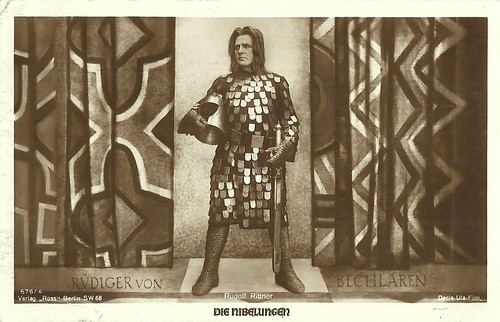
German postcard by Ross Verlag, no. 676/4. Photo: Decla-Ufa-Film. Rudolf Rittner as Rüdiger von Bechlaren in Fritz Lang's historical drama Die Nibelungen, part II (1924). The geometric patterns in the costumes and sets were inspired by book illustrations for a 1908-1909 edition of Die Nibelungen, edited at Gerlachs Jugendbücherei. These illustrations were by the Viennese artist Carl Otto Czeschka.
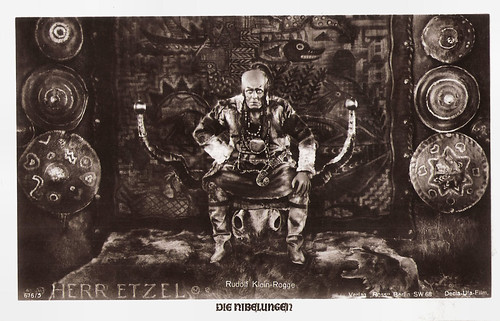
German postcard by Ross Verlag, no. 676/9. Photo: Decla-Ufa-Film. Rudolf Klein-Rogge as lord Etzel, King of the Huns, in Die Nibelungen (Fritz Lang, 1924), part II.
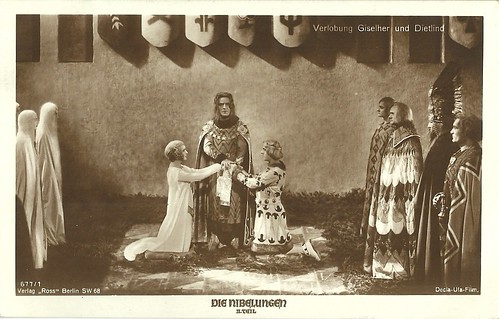
German postcard by Ross Verlag, no. 677/1. Photo: Decla-Ufa-Film. Publicity still for Die Nibelungen 2: Kriemhilds Rache/Die Nibelungen: Kriemhild's Revenge (Fritz Lang, 1924). The Betrothal of Giselher (Erwin Biswanger) and Dietlind (Annie Röttgen), led by her father Rüdiger von Bechlaren (Rudolf Rittner). To the right the Burgunds assist, including King Gunther (Theodor Loos), Hagen von Tronje (Hans Adalbert Schlettow) and Volker von Alzey (Bernhard Goetzke).

German postcard by Ross Verlag, Berlin, no. 677/2. Photo: Decla-Ufa-Film. Kriemhild (Margarete Schön) at the spring where Siegfried died. Publicity still for Die Nibelungen, part II, Kriemhilds Rache/Kriemhild's Revenge (Fritz Lang, 1924).
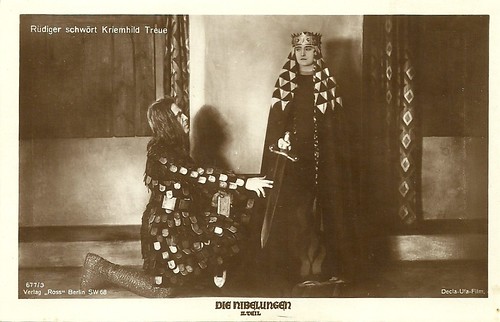
German postcard by Ross Verlag, no. 677/3. Photo: Decla-Ufa-Film. Publicity still for Die Nibelungen 2: Kriemhilds Rache/Die Nibelungen: Kriemhild's Revenge (Fritz Lang, 1924). At the beginning of Kriemhild's Rache Margrave Rüdiger von Bechlaren (Rudolf Ritttner) swears loyalty to the vengeful Kriemhild (Margarete Schön).
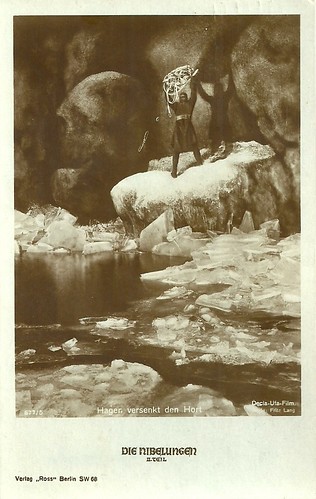
German postcard by Ross Verlag, no. 677/5. Photo: Decla-Ufa-Film. Publicity still for Die Nibelungen 2: Kriemhilds Rache/Die Nibelungen: Kriemhild's Revenge (Fritz Lang, 1924). Hagen von Tronje (Hans Adalbert Schlettow) dumps the Nibelungen treasure, which has been the cause of so much fight, jealousy and even murder.
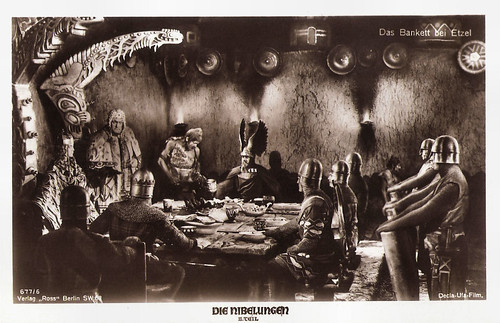
German postcard by Ross Verlag, no. 677/6. Photo: Decla-Ufa-Film. Publicity still for Die Nibelungen, II, Kriemhilds Rache/Kriemhild's Revenge (Fritz Lang, 1924). Caption: The Banquet at Etzel's, King of the Huns. During the banquet the knights discover it is a trap. Hagen von Tronje (Hans Adalbert Schlettow) kills the child of Etzel (Rudolf Klein-Rogge) and Kriemhild (Margarete Schön), after which Etzel swears to kill all Burgunds. Several are killed in fights. Finally, the banqueting hall is set on fire, killing all but Hagen and king Gunther. Most sets of the film were done by Erich Kettelhut, in collaboration with Otto Hunte and Karl Vollbrecht.
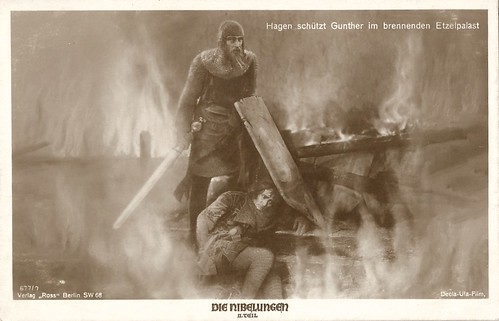
German postcard by Ross Verlag, Berlin, no. 677/7. Photo: Decla-Ufa-Film. Publicity still for Die Nibelungen 2: Kriemhilds Rache/Die Nibelungen: Kriemhild's Revenge (Fritz Lang, 1924). Hagen von Tronje (Hans Adalbert Schlettow) protects King Gunther (Theodor Loos) in the burning palace of Etzel.
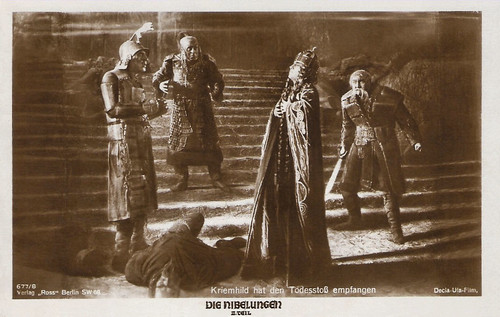
German postcard by Ross Verlag, Berlin, no. 671/8. Photo: Decla-Ufa-Film. Publicity still for Die Nibelungen 2: Kriemhilds Rache/Die Nibelungen: Kriemhild's Revenge (Fritz Lang, 1924). Kriemhild (Margarete Schön) has got the deathblow. In the back, King Hetzel (Rudolf Klein-Rogge) looks on in astonishment.
See how Siegfried slays the dragon in a clip of Die Nibelungen (Fritz Lang, 1924). Source: Gtelloz (YouTube).
Sources: Claudio Carvalho (IMDb), Thomas Staedeli (Cyranos), Encyclopedia Britannica, IMDb and Wikipedia.
This post was last updated on 3 May 2023.
Having heard The Met's wonderful Die Walküre last week, it was very interesting reading about this version of the tale. I wish it was available here on DVD. Thank you Bob for this well written and researched post.
ReplyDelete